A Non-Enzyme and Non-Label Sensitive Fluorescent Aptasensor Based on Simulation-Assisted and Target-Triggered Hairpin Probe Self-Assembly for Ochratoxin a Detection
Abstract
:1. Introduction
2. Result and Discussion
2.1. Mechanism for OTA Detection
2.2. Verification of Feasibility by Computer Simulation and Biological Experiments
2.3. Optimization of OTA Detection Conditions
2.4. Sensitivity and Specificity
2.5. Application in Practical Samples
3. Conclusions
4. Materials and Methods
4.1. Reagents
4.2. Instrumentation
4.3. Fluorescent Detection of OTA
4.4. OTA Detection in Wheat Flour and Red Wine Samples
Author Contributions
Funding
Conflicts of Interest
References
- Pfohl-Leszkowicz, A.; Manderville, R.A. Ochratoxin A: An overview on toxicity and carcinogenicity in animals and humans. Mol. Nutr. Food Res. 2007, 51, 61–99. [Google Scholar] [CrossRef] [PubMed]
- Hussein, H.S.; Brasel, J.M. Toxicity, metabolism, and impact of mycotoxins on humans and animals. Toxicology 2001, 167, 101–134. [Google Scholar] [CrossRef]
- Lei, L.; Cheng, B.C.; Cheng, Y.L.; Wu, R.Q.; Wang, S.H.; Guo, Z.J. Aptamer-based single-walled carbon nanohorn sensors for ochratoxin A detection. Food Control 2016, 60, 296–301. [Google Scholar]
- Varga, J.; Kozakiewicz, Z. Ochratoxin A in grapes and grape-derived products. Trends Food Sci. Technol. 2006, 17, 72–81. [Google Scholar] [CrossRef]
- Malir, F.; Ostry, V.; Novotna, E. Toxicity of the mycotoxin ochratoxin A in the light of recent data. Toxin Rev. 2013, 32, 19–33. [Google Scholar] [CrossRef]
- Duarte, S.C.; Pena, A.; Lino, C.M. A review on ochratoxin A occurrence and effects of processing of cereal and cereal derived food products. Food Microbiol. 2010, 27, 187–198. [Google Scholar] [CrossRef]
- European Commission. Commission regulation (EC) no 1881/2006 of 19 December 2006 setting maximum levels for certain contaminants in foodstuffs. Off. J. Eur. Union 2006, L364, 5–24. [Google Scholar]
- Abrunhosa, L.; Paterson, R.R.M.; Venâncio, A. Biodegradation of ochratoxin A for food and feed decontamination. Toxins 2010, 2, 1078–1099. [Google Scholar] [CrossRef] [Green Version]
- O’Brien, E.; Dietrich, D.R. Ochratoxin A: The continuing enigma. Crit. Rev. Toxicol. 2005, 35, 33–60. [Google Scholar] [CrossRef]
- Pittet, A.; Royer, D. Rapid, low cost thin-layer chromatographic screening method for the detection of ochratoxin A in green coffee at a control level of 10 μg/kg. J. Agric. Food Chem. 2002, 50, 243–247. [Google Scholar] [CrossRef]
- Zhu, W.Y.; Ren, C.; Nie, Y.; Xu, Y. Quantification of ochratoxin A in Chinese liquors by a new solid-phase extraction clean-up combined with HPLC-FLD method. Food Control 2016, 64, 37–44. [Google Scholar] [CrossRef]
- Mariño-Repizo, L.; Goicoechea, H.; Raba, J.; Cerutti, S. A simple, rapid and novel method based on salting-out assisted liquid–liquid extraction for ochratoxin A determination in beer samples prior to ultra-high-performance liquid chromatography coupled to tandem mass spectrometry. Food Addit. Contam. A 2018, 35, 1622–1632. [Google Scholar] [CrossRef] [PubMed]
- Ali, M.; Yeun-Mun, C.; Guan, H.T.; Lukman, B.A. Determination of mycotoxins using hollow fiber dispersive liquid–liquid–microextraction (HF-DLLME) prior to high-performance liquid chromatography – tandem mass spectrometry (HPLC-MS/MS). Anal. Lett. 2019, 52, 1976–1990. [Google Scholar]
- Olsson, J.; Börjesson, T.; Lundstedt, T.; Schnürer, J. Detection and quantification of ochratoxin A and deoxynivalenol in barley grains by GC-MS and electronic nose. Int. J. Food Microbiol. 2002, 72, 203–214. [Google Scholar] [CrossRef]
- Al Rubaye, A.G.; Nabok, A.; Catanante, G.; Marty, J.L.; Takacs, E.; Szekacs, A. Detection of ochratoxin A in aptamer assay using total internal reflection ellipsometry. Sens. Actuators B Chem. 2018, 263, 248–251. [Google Scholar] [CrossRef] [Green Version]
- Al Rubaye, A.G.; Nabok, A.; Catanante, G.; Marty, J.L.; Takacs, E.; Szekacs, A. Label-free optical detection of mycotoxins using specific aptamers immobilized on gold nanostructures. Toxins 2018, 10, 291. [Google Scholar] [CrossRef] [Green Version]
- Radoi, A.; Dumitru, L.; Barthelmebs, L.; Marty, J.L. Ochratoxin A in some French wines: Application of a direct competitive ELISA based on an OTA-HRP conjugate. Anal. Lett. 2009, 42, 1187–1202. [Google Scholar] [CrossRef]
- Wei, T.; Ren, P.P.; Huang, L.L.; Ouyang, Z.C.; Wang, Z.Y. Simultaneous detection of aflatoxin B1, ochratoxin A, zearalenone and deoxynivalenol in corn and wheat using surface plasmon resonance. Food Chem. 2019, 300, 125176. [Google Scholar] [CrossRef]
- Zhu, Z.L.; Feng, M.X.; Zuo, L.M.; Zhu, Z.T.; Wang, F.W.; Chen, L. An aptamer based surface plasmon resonance biosensor for the detection of ochratoxin A in wine and peanut oil. Biosens. Bioelectron. 2015, 65, 320–326. [Google Scholar] [CrossRef]
- Prieto-Simon, B.; Campas, M.; Marty, J.L.; Noguer, T. Novel highly-performing immunosensor-based strategy for ochratoxin A detection in wine samples. Biosens. Bioelectron. 2008, 23, 995–1002. [Google Scholar] [CrossRef]
- Ellington, A.D.; Szostak, J.W. In Vitro selection of RNA molecules that bind specific ligands. Nature 1990, 346, 818–822. [Google Scholar] [CrossRef] [PubMed]
- Lorenz, C.; Renée, S. The Aptamer Handbook: Functional Oligonucleotides and Their Applications, 2nd ed.; Wiley–VCH: Weinheim, Germany, 2006; pp. 94–190. [Google Scholar]
- Cruz-Aguado, J.A.; Penner, G. Determination of ochratoxin A with a DNA aptamer. J. Agric. Food Chem. 2008, 56, 10456–10461. [Google Scholar] [CrossRef] [PubMed]
- Wang, C.Q.; Qian, J.; Wang, K.; Yang, X.W.; Liu, Q.; Hao, N.; Wang, C.K.; Dong, X.Y.; Huang, X.Y. Colorimetric aptasensing of ochratoxin A using Au@Fe3O4 nanoparticles as signal indicator and magnetic separator. Biosens. Bioelectron. 2015, 77, 1183–1191. [Google Scholar] [CrossRef] [PubMed]
- Goud, K.Y.; Reddy, K.K.; Satyanarayana, M.; Kummari, S.; Gobi, K.V. A review on recent developments in optical and electrochemical aptamer-based assays for mycotoxins using advanced nanomaterials. Microchim. Acta 2019, 187, 146–158. [Google Scholar] [CrossRef]
- Wu, H.L.; Kang, R.J.; Liang, X.J.; Cheng, Y.; Lv, L.; Guo, Z.J. Fluorometric aptamer assay for ochratoxin A based on the use of single walled carbon nanohorns and exonuclease III-aided amplification. Mirochim. Acta 2017, 185, 27–33. [Google Scholar] [CrossRef]
- Ma, C.B.; Wu, K.F.; Zhao, H.; Liu, H.S.; Wang, K.M.; Xia, K. Fluorometric aptamer-based determination of ochratoxin A based on the use of graphene oxide and RNase H-aided amplification. Microchim. Acta 2018, 185, 347–353. [Google Scholar] [CrossRef]
- Gu, C.; Yang, L.; Wang, M.; Zhou, N.; He, L.; Zhang, Z.; Du, M. A bimetallic (Cu-Co) Prussian Blue analogue loaded with gold nanoparticles for impedimetric aptasensing of ochratoxin A. Microchim. Acta 2019, 186, 1–10. [Google Scholar] [CrossRef]
- Wei, M.; Zhang, W.Y. A novel impedimetric aptasensor based on AuNPs–carboxylic porous carbon for the ultrasensitive detection of ochratoxin A. RSC Adv. 2017, 7, 28655–28660. [Google Scholar] [CrossRef] [Green Version]
- Shao, X.L.; Zhu, L.J.; Feng, Y.X.; Zhang, Y.Z.; Luo, Y.B.; Huang, K.L.; Xu, W.T. Detachable nanoladders: A new method for signal identification and their application in the detection of ochratoxin A (OTA). Anal. Chim. Acta 2019, 1087, 113–120. [Google Scholar] [CrossRef]
- Chen, J.H.; Fang, Z.Y.; Liu, J.; Zeng, L.W. A simple and rapid biosensor for ochratoxin A based on a structure-switching signaling aptamer. Food Control 2012, 25, 555–560. [Google Scholar] [CrossRef]
- Fu, B.; Cao, J.C.; Jiang, W.; Wang, L. A novel enzyme-free and label-free fluorescence aptasensor for amplified detection of adenosine. Biosens. Bioelectron. 2013, 44, 52–56. [Google Scholar] [CrossRef] [PubMed]
- Xu, S.P.; Chen, X.J.; Peng, G.; Ling, J.; He, H. An electrochemical biosensor for the detection of Pb2+ based on g-quadruplex dna and gold nanoparticles. Anal. Bioanal. Chem. 2018, 410, 5879–5887. [Google Scholar] [CrossRef] [PubMed]
- Choi, M.S.; Yoon, M.; Baeg, J.O.; Kim, J. Label-free dual assay of DNA sequences and potassium ions using an aptamer probe and a molecular light switch complex. Chem. Commun. 2009, 47, 7419–7421. [Google Scholar] [CrossRef] [PubMed]
- Dirks, R.M.; Pierce, N.A. From the cover: Triggered amplification by hybridization chain reaction. Proc. Natl. Acad. Sci. USA 2004, 101, 15275–15278. [Google Scholar] [CrossRef] [Green Version]
- Ma, C.; Liu, H.Y.; Tian, T.; Son, X.R.; Yu, J.H.; Yan, M. A simple and rapid detection assay for peptides based on the specific recognition of aptamer and signal amplification of hybridization chain reaction. Biosens. Bioelectron. 2016, 83, 15–18. [Google Scholar] [CrossRef]
- Shi, Z.l.; Zhang, X.F.; Cheng, R.; Li, B.X.; Jin, Y. Sensitive detection of intracellular RNA of human telomerase by using graphene oxide as a carrier to deliver the assembly element of hybridization chain reaction. Analyst 2016, 141, 2727–2732. [Google Scholar] [CrossRef]
- Ren, D.X.; Sun, C.J.; Huang, Z.J.; Luo, Z.W.; Zhou, C.; Li, Y.X. A novel FRET biosensor based on four-way branch migration HCR for Vibrio parahaemolyticus detection. Sens. Actuators B Chem. 2019, 296, 126577. [Google Scholar] [CrossRef]
- Sen, D.; Gilbert, W. A sodium-potassium switch in the formation of four-stranded G4-DNA. Nature 1990, 344, 410–414. [Google Scholar] [CrossRef]
- Hu, D.; Pu, F.; Huang, Z.Z.; Ren, J.S.; Qu, X.G. A quadruplex-based, label-free, and real-time fluorescence assay for RNase H activity and inhibition. Chem. Eur. J. 2010, 16, 2605–2610. [Google Scholar] [CrossRef]
- Guo, L.Q.; Nie, D.D.; Qiu, C.Y.; Zheng, Q.S.; Wu, H.Y.; Ye, P.R.; Hao, Y.L.; Fu, F.F. A G-quadruplex based label-free fluorescent biosensor for lead ion. Biosens. Bioelectron. 2012, 35, 123–127. [Google Scholar] [CrossRef]
- Mccaskill, J.S. The equilibrium partition function and base pair binding probabilities for RNA secondary structure. Biopolymers 1990, 29, 1105–1119. [Google Scholar] [CrossRef] [PubMed]
- Guo, Q.Q.; Chen, Y.; Song, Z.P.; Guo, L.Q.; Fu, F.F.; Chen, G.N. Label-free and enzyme-free sensitive fluorescent detection of human immunodeficiency virus deoxyribonucleic acid based on hybridization chain reaction. Anal. Chim. Acta 2014, 852, 244–249. [Google Scholar] [CrossRef] [PubMed]
- Dirks, R.M.; Bois, J.S.; Schaeffer, J.M.; Winfree, E.; Pierce, N.A. Thermodynamic analysis of interacting nucleic acid strands. SIAM Rev. 2007, 49, 65–88. [Google Scholar] [CrossRef] [Green Version]
- Waterman, M.S. Secondary Structure of Single-Stranded Nucleic Acids. In Studies in Foundations and Combinatorics. Advances in Mathematics Supplementary Studies; Rota, G.-C., Ed.; Academic Press: New York, NY, USA, 1978; Volume 1, pp. 167–212. [Google Scholar]
- Mathews, D.H.; Sabina, J.; Zuker, M.; Turner, D.H. Expanded sequence dependence of thermodynamic parameters improves prediction of RNA secondary structure. J. Mol. Biol. 1999, 288, 911–940. [Google Scholar] [CrossRef] [PubMed] [Green Version]
- Tinoco, I.; Uhlenbeck, O.C.; Levine, M.D. Estimation of secondary structure in ribonucleic acids. Nature 1971, 230, 362–367. [Google Scholar] [CrossRef]
- Zadeh, J.N.; Steenberg, C.D.; Bois, J.S.; Wolfe, B.R.; Pierce, M.B.; Khan, A.R.; Dirks, R.M.; Pierce, N.A. Nupack: Analysis and design of nucleic acid systems. J. Comput. Chem. 2011, 32, 170–173. [Google Scholar] [CrossRef]
- Lakin, M.R.; Youssef, S.; Polo, F.; Emmott, S.; Phillips, A. Visual DSD: A design and analysis tool for DNA strand displacement systems. Bioinformatics 2011, 27, 3211–3213. [Google Scholar] [CrossRef]
- Huang, X.L.; Zhan, S.N.; Xu, H.Y.; Meng, X.W.; Xiong, Y.H.; Chen, X.Y. Ultrasensitive fluorescence immunoassay for detection of ochratoxin A using catalase-mediated fluorescence quenching of CdTe QDs. Nanoscal 2016, 8, 9390–9397. [Google Scholar] [CrossRef]
- Liu, F.; Ding, A.; Zheng, J.S.; Chen, J.C.; Wang, B. A label-free aptasensor for ochratoxin A detection based on the structure switch of aptamer. Sensors 2018, 18, 1769. [Google Scholar] [CrossRef] [Green Version]
- Shen, P.; Li, W.; Liu, Y.; Ding, Z.; Deng, Y.; Zhu, X.R.; Jin, Y.H.; Li, Y.C.; Li, J.L.; Zheng, T.S. High-throughput low background G-quadruplex aptamer chemiluminescence assay for ochratoxin a using a single photonic crystal microsphere. Anal. Chem. 2017, 89, 11862–11868. [Google Scholar] [CrossRef]
- Jo, E.J.; Mun, H.; Kim, S.J.; Shim, W.B.; Kim, M.G. Detection of ochratoxin A (OTA) in coffee using chemiluminescence resonance energy transfer (CRET) aptasensor. Food Chem. 2016, 194, 1102–1107. [Google Scholar] [CrossRef] [PubMed]
- Zejli, H.; Goud, K.Y.; Marty, J.L. Label free aptasensor for ochratoxin A detection using polythiophene-3-carboxylic acid. Talanta 2018, 185, 513–519. [Google Scholar] [CrossRef] [PubMed]

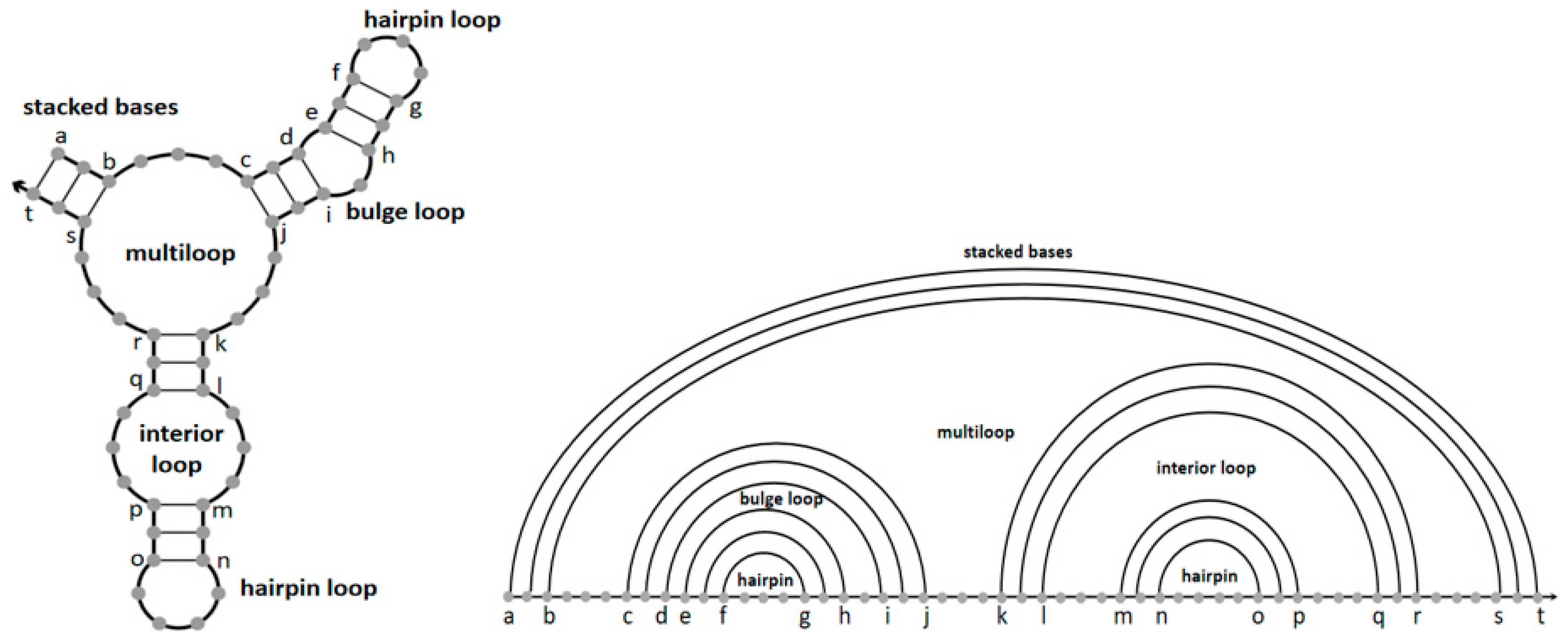
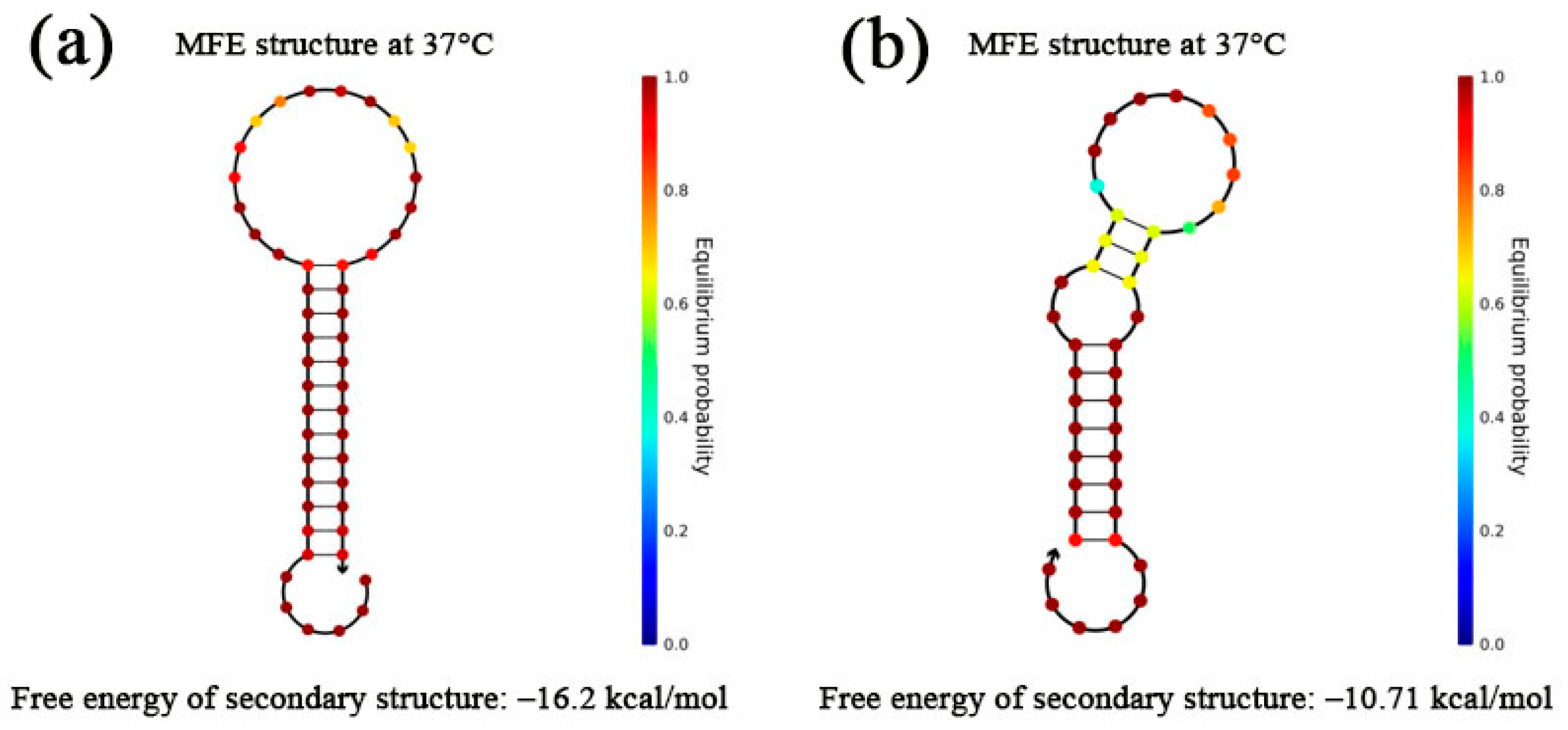
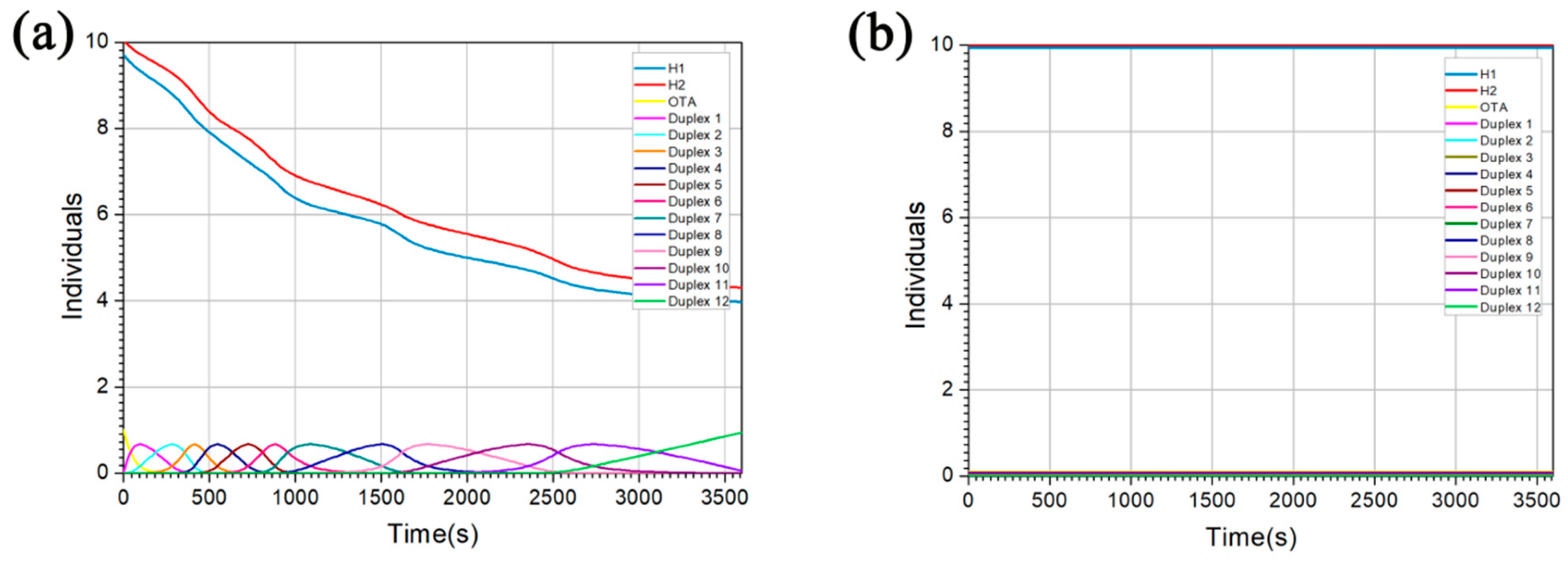
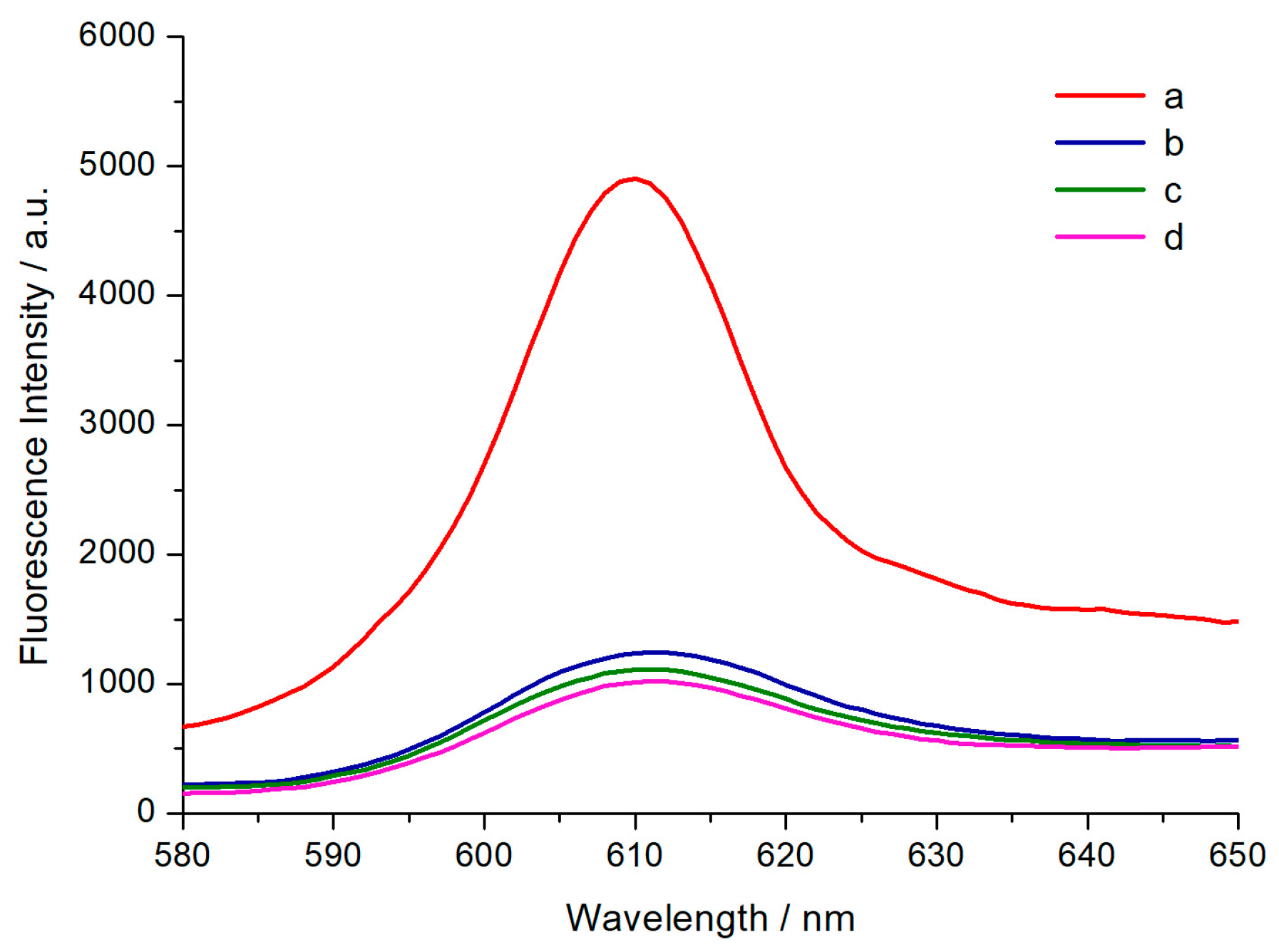
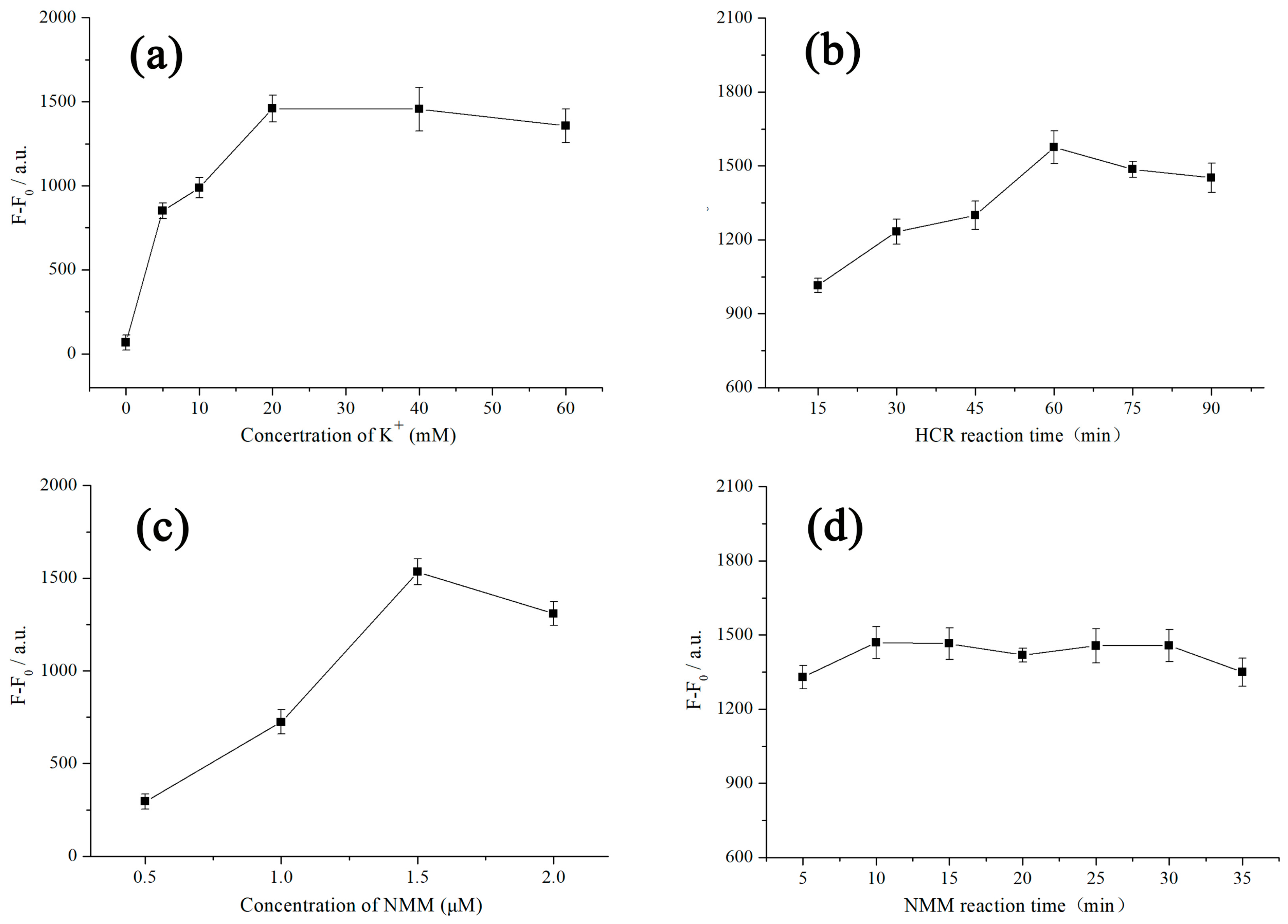


| Detection Method | Matrix | LOD | References |
|---|---|---|---|
| colorimetric | peanuts, corn | 74.3 pM | [21] |
| fluorescence | bear, red wine | 4.2 nM | [23] |
| fluorescence | red wine | 198.1 pM | [24] |
| electrochemical | soybean | 5.2 fg mL−1 | [26] |
| immunofluorescence | corn, rice, wheat | 0.12 pM | [50] |
| fluorescence | corn flour | 30 pM | [51] |
| chemiluminescence | wheat, rice, core | 10.6 pM | [52] |
| chemiluminescence | coffee | 0.5 nM | [53] |
| electrochemical | coffee | 0.125 ng mL−1 | [54] |
| fluorescence | wheat flour, red wine | 4.9 pM | this work |
| Samples | Added (pM) | Found (pM) | Recovery (%) a | RSD (%) b | |
|---|---|---|---|---|---|
| Wheat flour | 1 | 10 | 10.5 | 105 | ±4.1 |
| 2 | 50 | 48.9 | 97.9 | ±3.3 | |
| 3 | 100 | 104.8 | 104.8 | ±4.8 | |
| Red wine | 1 | 10 | 9.4 | 94 | ±3.7 |
| 2 | 50 | 48.4 | 96.8 | ±5.1 | |
| 3 | 100 | 95.7 | 95.7 | ±4.9 | |
© 2020 by the authors. Licensee MDPI, Basel, Switzerland. This article is an open access article distributed under the terms and conditions of the Creative Commons Attribution (CC BY) license (http://creativecommons.org/licenses/by/4.0/).
Share and Cite
Qian, M.; Hu, W.; Wang, L.; Wang, Y.; Dong, Y. A Non-Enzyme and Non-Label Sensitive Fluorescent Aptasensor Based on Simulation-Assisted and Target-Triggered Hairpin Probe Self-Assembly for Ochratoxin a Detection. Toxins 2020, 12, 376. https://0-doi-org.brum.beds.ac.uk/10.3390/toxins12060376
Qian M, Hu W, Wang L, Wang Y, Dong Y. A Non-Enzyme and Non-Label Sensitive Fluorescent Aptasensor Based on Simulation-Assisted and Target-Triggered Hairpin Probe Self-Assembly for Ochratoxin a Detection. Toxins. 2020; 12(6):376. https://0-doi-org.brum.beds.ac.uk/10.3390/toxins12060376
Chicago/Turabian StyleQian, Mengyao, Wenxiao Hu, Luhui Wang, Yue Wang, and Yafei Dong. 2020. "A Non-Enzyme and Non-Label Sensitive Fluorescent Aptasensor Based on Simulation-Assisted and Target-Triggered Hairpin Probe Self-Assembly for Ochratoxin a Detection" Toxins 12, no. 6: 376. https://0-doi-org.brum.beds.ac.uk/10.3390/toxins12060376





